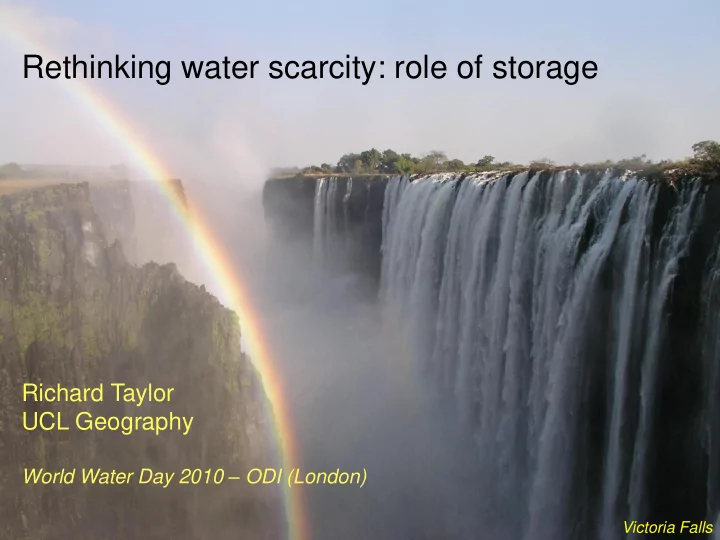

Rethinking water scarcity: role of storage Richard Taylor UCL Geography World Water Day 2010 – ODI (London) Victoria Falls
outline • water scarcity – defining the ‘global water crisis’ • water stress index – a critical review • water scarcity, storage & demand – informing adaptation
the global water crisis… in the news Newspaper headlines on water scarcity
water scarcity: ratio between renewable freshwater resources and human demand for freshwater resources per capita < 1000 m 3 per year ( Water Stress Index ) freshwater withdrawals/resources > 0.4 ( Relative Water Demand ) large-diameter well in a sand river NE Botswana (headwater of the River Limpopo)
estimating freshwater demand • based human freshwater use - 100L/person/day = 40m 3 /person/year (domestic) • inherently linked to population growth collecting water from a spring in Kampala
• associated agricultural, industrial & energy needs: 20 x 40m 3 /person/year • total per capita : 840m 3 /year >1700m 3 /person/year (water sufficient) <1700m 3 /person/year (water stressed) <1000m 3 /person/year (water scarce) irrigation of Boro rice (Bangladesh)
estimating renewable freshwater resources: “ mean annual river runoff ” (MARR) River Nile @ Bujugali Falls, Uganda
global water crisis - projections - projected rise in the number of people living in water-scarce regions from 1-2.5 to 3-9 billion over the next century - vary by IPCC SRES scenario and water scarcity definition Oki & Kanae (2006) Science, 313, 1068-1072.
African water crisis - projections
no relation between scarcity & access
Water Stress Index does not consider water quality collecting water from open scoop wells, Iganga Uganda
Water Stress Index does not consider “environmental flows”
MARR – measure of freshwater resources • assumes changes in basin storage are negligible or unimportant • validity under climate change?
• MARR does not disaggregate between ephemeral flows (stormflow) and… C/ECHO/François Goemans Vilanculos Town, Mutarara District, Mozambique, 22 February 2007
and steady flows (baseflow). Water-well drilling in Rukungiri, Uganda Upper Nile Basin
• southern Africa has the most variable river discharge in the world McMahon et al., 2007. J. Hydrol., 347, 260-271. large-diameter well in a sand river NE Botswana (headwater of the River Limpopo)
Groundwater & Africa groundwater constitutes 25% of renewable freshwater resources in Asia; in Africa, it is 51%. Döll & Fiedler, 2008. HESS 12, 863-885. Internally renewable groundwater supplies in sub-Saharan Africa (1500 km 3 /year) are, however, estimated to be nearly double that of China and nearly four times that of India FAO, 2003. AquaStat on-line database. Food & Agriculture Organisation of the UN http://www.fao.org/ag/agl/aglw/aquatstat/main
MARR disregards soil-moisture storage yet, in sub- Saharan Africa, >95% of all food production derives from soil water matoke and tea growing in Bushenyi, Uganda
Water Stress Index does not inform adaptation to water shortages 1. to use water more efficiently Irrigated agriculture by groundwater-fed pivots in Zambia
2) to store more water Nalubaale Dam, Uganda
3) to withdraw water from basin storage Maize plantation irrigated by a groundwater-fed pivot, Katwe (Zambia)
water storage • major shift from fine tuning estimates of freshwater flows to basic research characterising accessible freshwater storage • potential of groundwater to improve resilience of communities in sub-Saharan Africa “The Kampala Statement” Groundwater & Climate in Africa www.gwclim.org
rethinking estimation of water demand • re-define water scarcity so that it better reflects how do people use water („green‟ and „blue‟ water resources) AGRA
redefining water scarcity • define basin storage requirements to meet water demand McMahon et al., 2007. Journal of Hydrology 347, 260-271.
small or large scale interventions to increase water storage could then be considered in relation to changing water demand (e.g. trading in virtual water) Merowe Dam, Sudan
UN Human Development Report 2006: Beyond scarcity: Power, poverty & the global water crisis “ We reject this [Malthusian perspective that global water problems are a problem of scarcity and population growth]. The availability of water is a concern for some countries. But the scarcity at the heart of the global water crisis is rooted in power, poverty and inequality, not in physical availability .”
summary • current water scarcity metrics do not represent well the magnitude and dimensions of the global water crisis • an improved metric is required that better considers water storage and demand to inform debates about power and economics (water policies) & to allocate resources but… at what scale and for whom? low-yielding well in Mbarara, Uganda
Recommend
More recommend